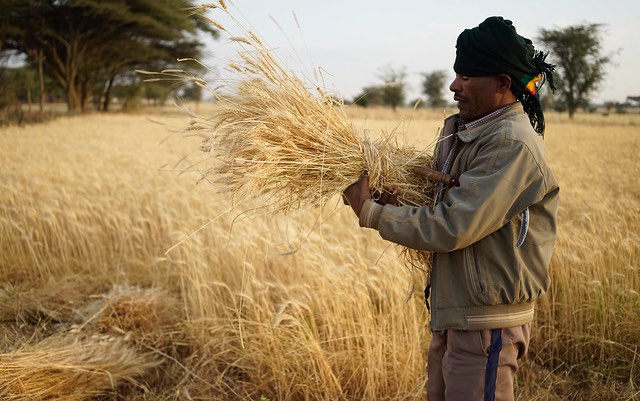In recent years, the global fight against chronic hunger and undernutrition has focused increasingly on ensuring access to the proper levels of nutrients and micronutrients. Driving this shift has been overwhelming scientific evidence showing caloric intake is not enough to prevent undernutrition and its maladies, and that certain nutrients are critical to human health and well-being. Hundreds of millions of people worldwide receive enough calories but suffer from a chronic deficiency in nutrients that negatively affects their cognitive and metabolic development.
Unfortunately, research is also showing that elevated atmospheric concentrations of CO2 (eCO2) might also affect the nutrient content of important crops such as maize, wheat, and legumes. Taking a new and more comprehensive approach to quantify the impacts climate change will have on nutrient availability, new research from IFPRI and partners published in Lancet Planetary Health projects climate change will reduce the global availability of protein, iron, and zinc significantly, slowing progress to reduce chronic and hidden hunger in the coming decades.
Global agricultural market models, including IFPRI’s IMPACT model, typically project that improvements in technology and markets will drive rising global food production and availability per capita over the next few decades, contributing to worldwide reductions in hunger and undernutrition. At the same time, changes in temperatures and precipitation are expected to reduce global crop yields, though these effects will differ across crops and regions. Through mid-century, the effects of climate change on agriculture are projected to slow the improvement of food production and availability, with negative consequences on global hunger compared to a world without climate change. To further complicate our estimates, some conflicting evidence is emerging suggesting rising atmospheric concentrations of CO2 may have a “fertilization” effect on crop yields, thereby offsetting some of the negative impacts from climatic changes.
To expand on past analyses of the climate effects on global and regional dietary outlooks, a team of scientists from IFPRI, RTI international, the U.S. Environmental Protection Agency (EPA), the Agricultural Research Service of the U.S. Department of Agriculture (USDA-ARS), the Australian government’s Commonwealth Scientific and Industrial Research Organisation (CSIRO), and Harvard University offered a new approach to quantify impacts on nutrient availability.
Future nutrient availability by 2050 has been captured by combining best available data on the potential effects of eCO2 n the nutrient content of food commodities with economic projections of future global diets that consider changes in agricultural production, prices, income, and consumption trends. This new work summarizes the effects of changes in both nutrient content and productivity of key agricultural commodities in 2050 due to climate (e.g. temperature and precipitation changes), economic changes, and eCO2 to provide a more comprehensive estimate of climate change impacts on global food security.
Consistent with previous studies, technological change, market responses, and CO2 yield fertilization all lead to increasing food availability and greater availability of dietary protein, iron, and zinc. However, these improvements are dampened by negative impacts of climate change on crop productivity and the net effect of rising atmospheric CO2 will be to slow down current progress in reducing global nutrient deficiencies.
Carbon penalties on nutrient content are estimated at between 2.5% and 4.1%. The carbon penalty from eCO2 on protein, iron, and zinc more than negates any benefits of CO2 yield fertilization. The combined effects of projected eCO2 (i.e., carbon nutrient penalty, CO2 yield fertilization, and climate effects on productivity) will slow growth in the global availability of protein, iron, and zinc to levels that are 19.5%, 14.4%, and 14.6% less, respectively, than they would otherwise be in 2050 with expected technology and market gains.
Source: Lancet Planetary Health. (Note: The total effect, indicated by the vertical line across the bar, is the cumulative
influence of all factors considered in this study. Further details provided in main article.)
The human health impact is likely to be much more consequential in low- and middle-income countries where the nutrient levels are lower than in rich countries, and therefore worse when compared to the WHO recommended nutrient intake (RNI).
The challenge of counteracting these projected losses can be met only if we understand and acknowledge the importance of proper nutrition. Increasing the global quality of nutrition is fundamental not just to the goal of eliminating all hunger by 2030 (SDG2) but underpins many other goals in the areas of poverty, education, work and economic growth, and inequality. By improving health, nutrition fundamentally allows human beings to realize their full potential, and it is, therefore, a key driver of sustainable development.
On the bright side, nutrition investments have been growing across the world, following mounting evidence of their economic returns. Development agencies, companies, and aid donors have mobilized to combat malnutrition in recent years, and several countries have shown large gains thanks to targeted nutrition interventions, and policies to advance nutrition quality implemented across a range of economic and social sectors.
The financing and policy efforts are a positive sign, but they are still insufficient to reach the goals of SDG2 and the 2025 targets of the World Health Assembly. The results of this study provide additional impetus to the call for increased financing and a stronger international effort toward combating undernutrition. Additional commitments to public health programs that address dietary risk factors represent a worthy climate change adaptation strategy, as they would directly counteract climate-related health effects.
Nicola Cenacchi is a Senior Research Analyst with IFPRI’s Environment and Production Technology Division (EPTD). Timothy Sulser is an IFPRI Senior Scientist working with the CGIAR Global Futures and Strategic Foresight initiative (GFSF).
This research was carried out with support from the U.S. Environmental Protection Agency (EPA), the CGIAR Research Program on Policies, Institutions and Markets (PIM) led by IFPRI, and the CGIAR Research Program on Climate Change and Food Security (CCAFS).







